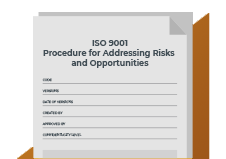Assign topic to the user
Answer:
Every issue included in the SWOT matrix can be used to determine risks and opportunities.
Consider, as an example, a small sample of a SWOT matrix of an organization 
Remember the ISO 9000:2015 definition of risk - risk as the effect of uncertainty. And then, in a note, the standard states that an effect is a deviation from the expected – positive or negative.
So, consider an overall desired outcome for the quality management system, an expected result: Win more sales from new customers.
Risks will work against meeting that expected a result. Opportunities will work helping in meeting that expected a result. 
The organization can match the Opportunity with the Strength at the SWOT matrix above, and raise an opportunity:
Win new customers that were served by the now-closed competitor making use of our fast sampling skills; htt ps://
The organization can match the Threat with the Weakness at the SWOT matrix above, and raise a risk:
Economically weaker subcontractor could no longer be profitable and close without orders from the now-closed competitor. Our orders alone don’t sustain him. Without that subcontractor capacity, we can win orders that we cannot serve due to our assembling capacity shortage
The following material will provide you with information about the risk-based approach:
- ISO 9001 – Five Main Steps in ISO 9001 Internal Audit - https://advisera.com/9001academy/knowledgebase/five-main-steps-in-iso-9001-internal-audit/
- free online training ISO 9001:2015 Internal Auditor Course
– https://advisera.com/training/iso-9001-internal-auditor-course/
- Free webinar – How to implement risk management in ISO 9001:2015 - https://advisera.com/9001academy/webinar/how-to-implement-risk-management-in-iso-90012015-free-webinar-on-demand//
- book - ISO Internal Audit: A Plain English Guide - https://advisera.com/books/iso-internal-audit-plain-english-guide/
Comment as guest or Sign in
Feb 04, 2019


